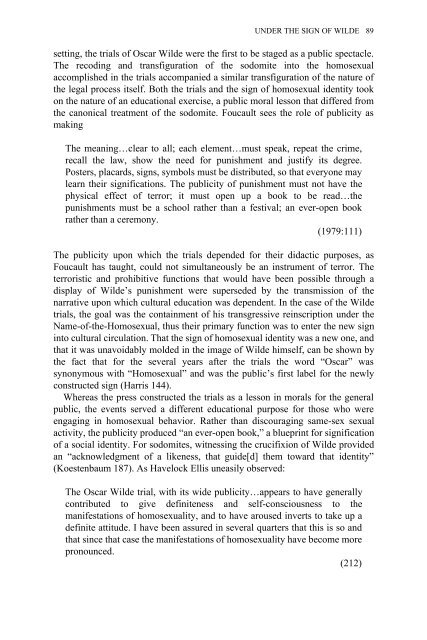Edited by Moe Meyer - Get a Free Blog
Edited by Moe Meyer - Get a Free Blog
Edited by Moe Meyer - Get a Free Blog
You also want an ePaper? Increase the reach of your titles
YUMPU automatically turns print PDFs into web optimized ePapers that Google loves.
UNDER THE SIGN OF WILDE 89<br />
setting, the trials of Oscar Wilde were the first to be staged as a public spectacle.<br />
The recoding and transfiguration of the sodomite into the homosexual<br />
accomplished in the trials accompanied a similar transfiguration of the nature of<br />
the legal process itself. Both the trials and the sign of homosexual identity took<br />
on the nature of an educational exercise, a public moral lesson that differed from<br />
the canonical treatment of the sodomite. Foucault sees the role of publicity as<br />
making<br />
The meaning…clear to all; each element…must speak, repeat the crime,<br />
recall the law, show the need for punishment and justify its degree.<br />
Posters, placards, signs, symbols must be distributed, so that everyone may<br />
learn their significations. The publicity of punishment must not have the<br />
physical effect of terror; it must open up a book to be read…the<br />
punishments must be a school rather than a festival; an ever-open book<br />
rather than a ceremony.<br />
(1979:111)<br />
The publicity upon which the trials depended for their didactic purposes, as<br />
Foucault has taught, could not simultaneously be an instrument of terror. The<br />
terroristic and prohibitive functions that would have been possible through a<br />
display of Wilde’s punishment were superseded <strong>by</strong> the transmission of the<br />
narrative upon which cultural education was dependent. In the case of the Wilde<br />
trials, the goal was the containment of his transgressive reinscription under the<br />
Name-of-the-Homosexual, thus their primary function was to enter the new sign<br />
into cultural circulation. That the sign of homosexual identity was a new one, and<br />
that it was unavoidably molded in the image of Wilde himself, can be shown <strong>by</strong><br />
the fact that for the several years after the trials the word “Oscar” was<br />
synonymous with “Homosexual” and was the public’s first label for the newly<br />
constructed sign (Harris 144).<br />
Whereas the press constructed the trials as a lesson in morals for the general<br />
public, the events served a different educational purpose for those who were<br />
engaging in homosexual behavior. Rather than discouraging same-sex sexual<br />
activity, the publicity produced “an ever-open book,” a blueprint for signification<br />
of a social identity. For sodomites, witnessing the crucifixion of Wilde provided<br />
an “acknowledgment of a likeness, that guide[d] them toward that identity”<br />
(Koestenbaum 187). As Havelock Ellis uneasily observed:<br />
The Oscar Wilde trial, with its wide publicity…appears to have generally<br />
contributed to give definiteness and self-consciousness to the<br />
manifestations of homosexuality, and to have aroused inverts to take up a<br />
definite attitude. I have been assured in several quarters that this is so and<br />
that since that case the manifestations of homosexuality have become more<br />
pronounced.<br />
(212)


